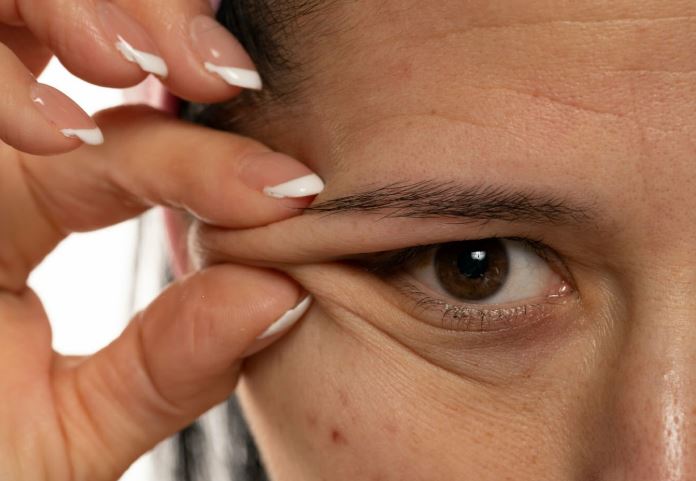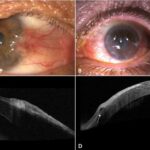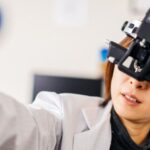Uneven eyelids refer to the asymmetrical appearance of the upper or lower eyelids. While the condition itself may not be a serious medical condition, it may be a sign of a serious health decline. Uneven eyelids can significantly impact a person’s self-esteem and confidence because most people focus on the eyes when they look at someone. Although it’s estimated that only 2% of the population has perfect facial symmetry, most individuals have slightly asymmetrical facial features, including uneven eyelids. It is a common issue that can affect people of all ages.

Causes of Uneven Eyelids
There are several reasons why a person may have uneven eyelids, including some medical conditions. Some of the most common causes of uneven eyelids include:
Genetics
In the development of congenital eyelid abnormalities, genetics plays a vital role. Individuals may inherit slightly uneven or asymmetrical eyelids, which can become a source of concern if it is very noticeable. Seeking treatment for such concerns is possible and can help alleviate the impact of asymmetrical eyelids on one’s self-esteem.
Aging
As we age, our skin loses elasticity and begins to sag, which can lead to the development of uneven eyelids. On the upper eyelid, the skin and muscles stretch as elasticity is lost, and although both eyes will be affected, this may look more obvious in one eye. The aging process may also contribute to the uneven distribution of fat tissues around the eyelids, leading to asymmetry. The natural aging process can also cause changes to the facial bone structure, which may also contribute to the development of uneven eyelids.
A study into the relationship between age and facial asymmetry found that there was a more significant increase in asymmetry in the lower two-thirds of the face due to the loss of soft tissues. As we age, the asymmetry of the upper eyelids may become more noticeable and contribute to an overall less youthful appearance.
Trauma
Trauma is one of the major causes of uneven eyelids. It can lead to direct damage to the eyelid, which may affect the muscles that support the eyelid, causing it to become weak or even paralyzed. For instance, a penetrating injury can damage the muscles responsible for lifting the eyelids, resulting in drooping of the eyelids. Similarly, blunt force trauma can cause swelling and bruising of the eyelid, which can affect the symmetry of the eyes. In some cases, the trauma may also affect the nerves that control the eyelid muscles, leading to a condition called neurogenic ptosis. This condition can cause the eyelid to droop and affect the symmetry of the eyes. In severe cases, surgical intervention may be necessary to correct the asymmetry of the eyelids caused by trauma.
Lifestyle Factors
Lifestyle factors such as sun exposure, smoking, and alcohol consumption can contribute to the development of uneven eyelids. Sun damage can cause the skin to lose elasticity and collagen, leading to sagging and unevenness of the eyelids over time. Smoking causes premature aging and skin damage, including the thinning of the skin around the eyes, which can lead to asymmetry of the eyelids. Alcohol consumption can also contribute to dehydration, which can cause the skin to appear dull and less elastic.
Additionally, excessive alcohol consumption can lead to facial swelling and inflammation, which can affect the appearance of the eyelids. While lifestyle factors may not be the primary cause of uneven eyelids, they can exacerbate existing conditions and contribute to the development of new ones. It is essential to maintain a healthy lifestyle and protect the delicate skin around the eyes from sun damage to prevent the development or worsening of uneven eyelids.
Medical Conditions
TICS
Tics are sudden, repetitive, non-rhythmic movements (motor tics) or sounds (vocal tics) that occur involuntarily and are often difficult to suppress. They are a neurological disorder that can affect people of all ages and can result in uneven eyelids. Tics can cause excessive blinking or eye-rolling, leading to asymmetrical eyelids. When the muscles around the eyes contract repeatedly, one eyelid may droop more than the other, resulting in uneven eyelids.
In addition, tics can cause involuntary eye closure, which can also lead to asymmetrical eyelids. This can be especially noticeable during times of stress or anxiety when tics tend to worsen. While tics are generally benign, they can significantly impact a person’s quality of life, including their self-esteem and confidence. Treatment options for tics include medication, behavioral therapy, and relaxation techniques. In severe cases, surgery may be necessary to correct the asymmetry of the eyelids caused by tics.
Bell’s Palsy
Bell’s Palsy is a condition that affects the facial nerve, causing temporary weakness or paralysis of the muscles on one side of the face, including the eyelids. This condition can result in uneven eyelids due to the inability to close one eye fully and the drooping of one eyelid. The eyelid on the affected side may appear lower, and the eye may seem smaller. This can cause eye irritation, dryness, and difficulty blinking, leading to further complications such as dry eye, corneal abrasions, and infections. Bell’s Palsy can affect anyone, but it is more common in individuals between the ages of 15 and 60, pregnant women, and people with a family history of the condition.
Although the exact cause of Bell’s Palsy is unknown, medical professionals believe it is related to viral infections or inflammation of the facial nerve. Treatment options for Bell’s Palsy include medications, physical therapy, and surgery in severe cases. It is crucial to seek medical attention immediately if you experience any of the symptoms of Bell’s Palsy, including uneven eyelids, to avoid further complications.
Stroke
A stroke occurs when blood flow to the brain is interrupted, leading to brain cell damage and death. Depending on the area of the brain affected, different parts of the body may be impacted, including the eyes and eyelids. Uneven eyelids can occur due to a stroke that affects the nerves controlling the muscles responsible for eye movement and eyelid position.
Damage to the nerves can cause weakness or paralysis of the muscles, leading to drooping or uneven eyelids. The degree of eyelid droopiness may depend on the severity and location of the stroke. Severe cases may affect the eyelids to the extent that they interfere with vision, making it difficult to see properly. If you or someone you know experiences sudden eyelid drooping or other symptoms of a stroke, such as weakness on one side of the body or difficulty speaking, seek medical attention immediately, as prompt treatment can improve outcomes.
Myasthenia gravis
Myasthenia gravis is an autoimmune disease that affects the neuromuscular junction, which is the area where nerve impulses meet muscle cells. The condition causes the immune system to attack the receptors in the neuromuscular junction, leading to muscle weakness and fatigue. One of the most common symptoms of myasthenia gravis is drooping eyelids, also known as ptosis. This occurs because the muscles that control the eyelids become weaker, making it difficult for the affected individual to keep their eyes open. As a result, one or both of the eyelids may droop, causing an asymmetrical appearance.
In some cases, the ptosis may be severe enough to block the individual’s vision. Treatment options for ptosis caused by myasthenia gravis include medications that improve nerve impulse transmission, immunosuppressant drugs, and surgical intervention to correct the position of the eyelid.
Treatment Options for Uneven Eyelids
Non-Surgical Options
Non-surgical treatment options for uneven eyelids include makeup, eyelid exercises, and eyelid tape. Applying eyeliner or eyeshadow to the affected eyelid can create the illusion of symmetry. This can help to visually balance the appearance of the eyes.
You can also employ eyelid exercises to strengthen the muscles surrounding the eyes and improve eyelid symmetry. These exercises can include things like consciously opening and closing the eyes or using fingers to lift the eyelids.
Eyelid tape is a temporary solution that can be used to create the appearance of an even eyelid. The tape is applied to the affected eyelid to help lift and support it, creating a more symmetrical appearance. These non-surgical options are usually recommended for mild cases.
Surgical Options
Surgical treatment options for uneven eyelids include blepharoplasty, ptosis surgery, and brow lift. Blepharoplasty is a surgical procedure that removes excess skin, fat, and muscle from the eyelids to create a more youthful and symmetrical appearance. Surgeons commonly use this procedure to address sagging or drooping of the eyelids caused by aging or other factors.
Ptosis surgery is a procedure that corrects drooping of the upper eyelid by tightening the muscles that lift the eyelid. Doctors often recommend this surgery for individuals with more severe cases of eyelid asymmetry due to medical conditions or trauma.
Brow lift surgery is another option that lifts the forehead and eyebrows, creating a more youthful and alert appearance. This procedure is often recommended for individuals with significant brow drooping that contributes to eyelid asymmetry. Surgical options are usually recommended for more severe cases of uneven eyelids where non-surgical options are not effective. It is essential to consult with a qualified healthcare provider to determine the most appropriate treatment option for your specific needs.
In Summary
Various factors, including genetics, aging, trauma, medical conditions, and lifestyle factors can cause uneven eyelids. While non-surgical options such as makeup, eyelid exercises, and eyelid tape can effectively improve the appearance of uneven eyelids, surgical options such as blepharoplasty, ptosis surgery, and brow lift may be necessary in severe cases. It is essential to consult with a qualified healthcare provider to determine the underlying cause and the most appropriate treatment option.




